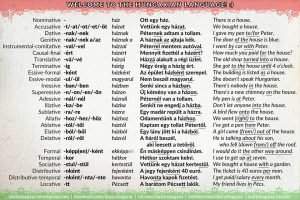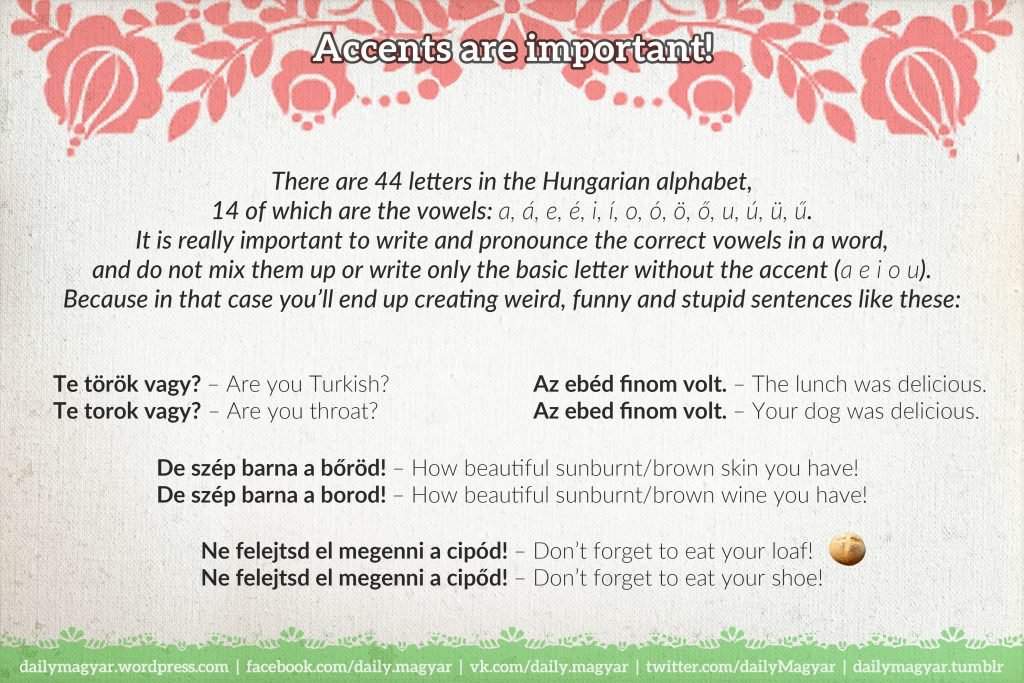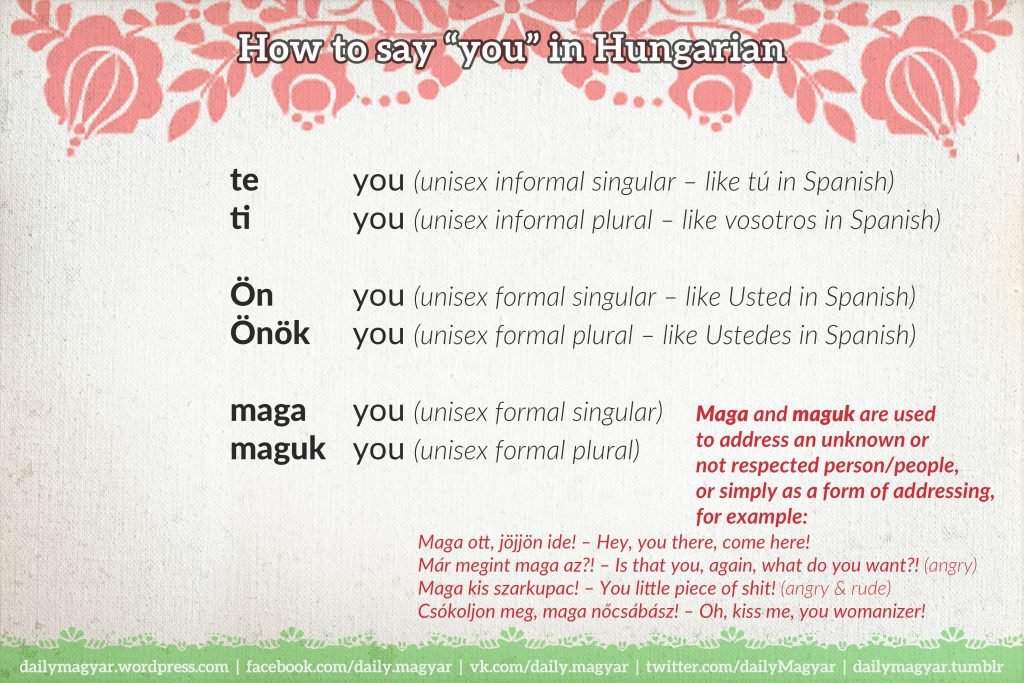Mini language lesson #3: Basic Hungarian grammar

Picking up the grammar is an essential part of being able to communicate in a certain language. Hungarian grammar can seem like and endless forest with millions of branches and exceptions, but we try to bring it a bit closer to you by our witty learning cards and useful examples. At the end of the day: you got to love Hungarian 🙂
Keep in mind that we are not linguists in any way, we’re just as dazzled by the curiosities of the Hungarian language as foreigners are. So this series doesn’t aim to explain the etymology of words, it’s more of a fun take on our language. We try to bring Hungarian closer to you with witty learning cards made by Daily magyar, a language-enthusiast person, whose posts give an insight into the complexity of the Hungarian grammar. But don’t worry, it’s all done in an easy-going way, so that it can make learning fun.
We’ve already focused on greetings and animals in our previous articles, and now we try to tackle some basic info about the Hungarian grammar. What’s funny is that even the Hungarian word for grammar, nyelvtan, stands out from how most nations call this concept. A quite promising start, right? 🙂
If you start learning Hungarian at a professional course, one of the first things that you’re probably going to hear is that our language has many grammatical cases. However, if you ask a Hungarian about how many cases there are in his language, the person will probably have no idea, because we learnt grammar through different methods. We divide suffixes and endings into three main categories: képző (derivational suffix / formative syllable), jel (inflectional suffix / signing syllable) and rag (case suffix / declining/conjugating/sticking syllable).
The following image might be shocking and overwhelming at first, but these are the grammatical cases that will probably confuse you, however, they form an essential part of our language. The bad news is that we use them all and daily, the good news is that this table is quite good and graphic. You will surely get the hang of it with time 🙂

Something else that you might find weird is that we have vowels that no other languages have. Some of our vowels have accents, which can make big differences in the meaning of words, so you should try to remember them, otherwise you might end up in funny situations.

Fun fact: the Hungarian equivalent of vowel is magánhangzó, which literally means “can make a sound alone”, while the equivalent of consonant is mássalhangzó, which literally means “can make a sound only when combined with something else”.
Another curiosity of our language is that we have two letters for a same phoneme, ‘j’ and ‘ly’. The correct writing of words that include the phoneme pronounces as ‘y’ in the English word ‘yes’ even causes troubles for native speakers. Most of us can probably recall the grammar lessons in primary school when we learnt about this phenomenon. One thing everybody remembers for sure is that there’s only one Hungarian word that starts with ‘ly’ – lyuk (hole) and its different forms. Don’t worry, this rule is even confusing and tricky for most Hungarians.
What makes Hungarian so complicated is that it is an agglutinative language. Agglutination permits formation of new words from nouns, verbs, adjectives and modifiers and other suffix components. Check out some examples that demonstrate the many possibilities:
sör – beer
sörözni – to drink beer
sörözés – beer-drinking
sörözgetés – beer-drinking once in a while
söröző
1) beer-drinking (person)
2) buttery; brasserie
fénykép – photograph
fényképezni – to take a photo
fényképezés – photographing
fényképezgetés – photographing from time-to-time
fényképezős
1) something that has a built-in photocamera
[e.g.: fényképezős mobiltelefon – mobile phone with photo camera]
2) the person who use to take photos
fényképész – photographer
fényképészet – photography (concept; notion; idea; firm)
fényképező
1) photo camera (also as ‘fényképezőgép’) [slang]
2) the person who takes/is taking photos
3) photographic
In Hungarian, there are words that you might hear in spoken language used both in questions and answers, statements. But the words used in questions, if are used in the answers, statements, etc, should be used only with the a- prefix, like:
– Mikor jöttél tegnap haza a buliból?
– Amikor bezárt a diszkó.
NOT
– Mikor bezárt a diszkó.
– When did you come home from the party yesterday?
– When the disco closed.
Each question word has its own relative pronoun pair: Mi? – Ami… (What), Ki? – Aki… (Who), Kié? – Akié… (Whose), Milyen? – Amilyen… (What kind of, like), Mikor? – Amikor… (When), Mivel? – Amivel… (With what), Hogyan? – Ahogyan… (How), Honnan? – Ahonnan… (From where), Hova? – Ahova… (To where), Hol? – Ahol… (Where) and so on 🙂
Last but not least, let’s take a look at personal pronouns and some variations.
én – I
te – you
ő – he/she/it
mi – we
ti – you (plural)
ők – they
mink – we [dialectical]
tík; tiktek – you (plural) [dialectical]
°
enyém – mine
tiéd – yours
övé – his/her/its
miénk – ours
tiétek – yours
övék – theirs
enyimé; enyím – mine [dialectical]
tiedé – yours [dialectical]
mienk; mienké – ours [dialectical]
tietek; tieteké; tikteké – yours [dialectical]
övéké; övüké; öviké – theirs [dialectical]
°
enyéim – mines (many things)
tieid – yours (many things)
övéi – his/her/its (many things)
mieink – ours (many things)
tieitek – yours (many things)
övéik – theirs (many things)
[e.g.: Azok a könyvek az enyéim. – Those books are mine.]
enyéimek; enyémek; enyímek; enyiméi – mines (many things) [dialectical]
tiedéi – yours (many things) [dialectical]
mienkéi – ours (many things) [dialectical]
tietekéi – yours (many things) [dialectical]
övékéi; övükéi – theirs (many things) [dialectical]
The first thing you probably noticed is that we don’t have separate genders for the third person. We use ‘ő’, the 27th letter of the Hungarian alphabet, which is not only a letter, but also a word that means “he” and “she”.
Moreover, in some cases “you” is used to call someone in a formal way. This is very common in our language when it comes to addressing unknown people, especially if they’re older than us or of high respect.

That’s about it for the third mini language lesson, we really hope you enjoyed it! 🙂
Photos: www.facebook.com/Dailymagyar
Copy editor: bm
Source: Daily News Hungary






It’s really interesting…..but impossible….I’ve lived in Balástya for 6 years, no- one wants to teach me basic Magyar. As an older lady my brain just cannot grasp the language. I speak French, Greek, some Spanish……..but Magyar defeats me…….???
Kate, if you still wants to learn I will teach you 🙂
In English, there is no such a grammatical construction as “I use to get up at 7”, which was used in the article, wrongly !!! If you want to use the present tense of the sentence “I used to get up 7”, you simply use “I [usually] get up at 7”. Just the way it works it Hungarian (szoktam kelni/kelek [általában]). You don’t say “szokok” in Hungarian either, unless you are a very uneducated person. “How much YOU PAID for the house?”, instead of “did you pay” was terrible to read also, made me cringe. I wouldn’t tell a sentence (“The ticket is 40 euros per man”) using “per man” either. That means ladies can enter free of charge, right? “per person” maybe, but “each” would be even better.
Teaching age-old, extinct pronouns, that nowadays are used exclusively by elder people on the county (like “mink” or “övüké”), just for the sake of emphasizing how complicated the language is, is just bullshit. Moreover, the pronoun “mine” absolutely does NOT sounds as “mines” in plural in English! You’d say “Those are mine”, NOT “Those are mines” when pointing to many objects (“enyiméi”, rofl). The second form would actually mean “aknák” (military)!
For the j/ly issue (not sure why it must be showcased in a mini-article, but whatever), you could have added the Spanish equivalent (just like with “Usted” later on), the pronunciation of “Yo” and “llorar” for example. That makes understanding a lot easier for people who happen to speak Spanish also.
When presenting the grammatical cases, you could/should have chosen words where the assimilation (changing the leading consonant of the suffix to the same as the ending consonant of the basic word) is NOT present. Showing “PéterREL” “házZÁ” as examples for -val/vel and -vá/vá must be baffling at first glance. 🙂
Really helpful!! ✨
Really helpful!! ✨
This post really good i want to comment only on the meme:
… we have the word gramatúrgia instead of nyelvtan its just not a common used term. Still wrong meme is wrong.
It has been a long time, really enjoyed